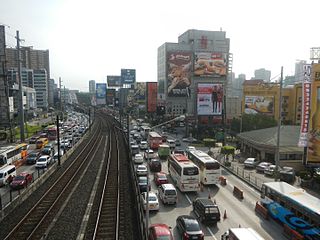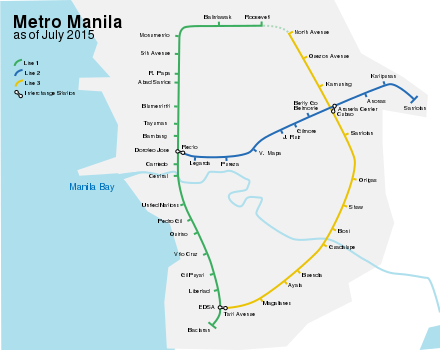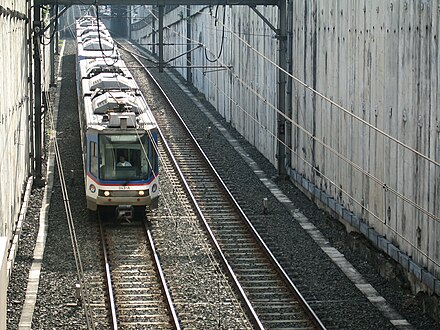Transportation in the Philippines is relatively underdeveloped partly due to the country's mountainous terrain and archipelagic state and as a result of the government's underspending on infrastructure. In recent years however, the Government of the Philippines has been improving transportation through various infrastructure projects.

Epifanio de los Santos Avenue, commonly referred to by its acronym EDSA, is a limited-access circumferential highway around Manila, the capital of the Philippines. It is the main thoroughfare in Metro Manila passing through 6 of the capital region's 17 local government units, namely, from north to south, Caloocan, Quezon City, San Juan, Mandaluyong, Makati and Pasay.

The Manila Metro Rail Transit System Line 3, also known as the MRT Line 3, MRT-3 or Metrostar Express is a rapid transit system of Metro Manila, Philippines. The line runs in an orbital north to south route following the alignment of the Epifanio de los Santos Avenue (EDSA). Although it has the characteristics of light rail, such as with the type of rolling stock used, it is more akin to a rapid transit system owing to its total grade separation and high passenger throughput.

Rail transportation in the Philippines is currently used mostly to transport passengers within Metro Manila and the nearby province of Laguna, as well as a commuter service in the Bicol Region. Freight transport services once operated in the country, but these services were halted. However, there are plans to restore old freight services and build new lines.

Gil Puyat station is a station on the Manila Light Rail Transit System Line 1. Like all other Line 1 stations, Gil Puyat station is above-ground. The station is located in Pasay and is named because the station lies immediately above Gil Puyat Avenue. The avenue itself is named for Gil Puyat, a late senator and statesman.

EDSA station is a station on the Manila Line 1. Like all other stations in the system, EDSA station is above-ground. The station is located on the intersection of Taft Avenue and Epifanio de los Santos Avenue, or EDSA, one of Metro Manila's main thoroughfares. The station was named after EDSA, which in turn is named after Epifanio de los Santos, a noted historian.

Baclaran station is a station on the Manila Light Rail Transit System Line 1. The station is located on the last stretches of Taft Avenue in Pasay, right at the border with Baclaran, Parañaque, and, like all other stations on the Line 1, Baclaran terminal is above-ground on viaduct. The terminal is named after the famous shopping district of the same name, which is located on the borders of the cities of Pasay and Parañaque.

The Department of Transportation is the executive department of the Philippine government responsible for the maintenance and expansion of viable, efficient, and dependable transportation systems as effective instruments for national recovery and economic progress. It is responsible for the country's land, air, and sea communications infrastructure.

The Ayala Station is a station on the Manila Metro Rail Transit System Line 3. Ayala station is one of the two underground stations that can be found on the line, the other being the Buendia station. The station is located in Makati and is named so due to its proximity to two places bearing the Ayala name: Ayala Center and Ayala Avenue.

Taft Avenue station is a station on the Manila Metro Rail Transit System Line 3, and is the line's only station in Pasay. The station is located at the corner of Epifanio de los Santos Avenue, or EDSA, one of Metro Manila's main thoroughfares, and Taft Avenue. The station is named after Taft Avenue, which is named after former U.S. President and U.S. Chief Justice William Howard Taft, who served as Governor-General of the Philippines from 1901 to 1903.

The Metro Rail Transit Corporation (MRTC), is a private consortium organized in June 1995. The consortium is composed of seven (7) Filipino-owned companies: Fil-Estate Management Inc, Ayala Land Inc, Ramcar Inc of National Book Store, Greenfield Development Corporation of Unilab, Anglo-Philippine Holdings Corporation, Allante Realty and Development Inc, and DBH Inc. The Metro Rail Transit Corporation owns the Manila Metro Rail Transit System Line 3 running along the EDSA corridor. MRTC was the original contractor for the EDSA MRT-3 Project. It runs the MRT-3 in coordination with the Department of Transportation under a 25-year Build-Lease-Transfer contract or BLT Agreement, which will end on the year 2025.

Magallanes Station is a station on the Manila Metro Rail Transit System Line 3. It is one of the many elevated stations found on the line. The station is named after the adjacent Magallanes district of Makati, which in turn is named after Ferdinand Magellan, who discovered the Philippines for Spain on April 15, 1521. Although the station is named after Magallanes, it also serves passengers from Kayamanan-C and barangays Dasmariñas, Pio del Pilar, and San Lorenzo in Makati, and those from Taguig.

The transportation system in Metro Manila is currently inadequate to accommodate the mobility and other basic needs of an densely populated metropolis, the result of many factors and problems that the government has failed to provide or address. Metro Manila exists in a state of near-permanent gridlock, with people and goods trapped by the very transportation system that is supposed to move them quickly and efficiently.

The Manila Metro Rail Transit System (MRT) is one of the two rapid transit systems serving Metro Manila in the Philippines along with the Manila Light Rail Transit System (LRTA). It originally began as a single line that was first opened in 1999 and became fully operational by the year 2000. Since then, most of the newly proposed rapid rail lines within Metro Manila that are not under the jurisdiction of the Light Rail Transit Authority is associated with the "MRT" brand. This includes the Line 9 and the elevated Line 7 which are being built as of January 2020.

The Philippine National Railways Metro Commuter Line is a commuter rail line operated by the Philippine National Railways, stretching from Tondo, Manila to the southern and northern edge of Metro Manila. Presently, there are 31 railway stations. The current line is colored orange on most maps.
The Metro Manila Dream Plan, formally titled the Roadmap for Transport Infrastructure Development for Metro Manila and Its Surrounding Areas, refers to an integrated plan for improving the transport system in Metro Manila, Philippines, with the hope of turning it into a focal point for addressing Metro Manila's interlinked problems in the areas of transportation, land use, and environment.
The Metro Rail Transit Line 4 is an approved monorail rapid transit line to be built in Metro Manila and Rizal in the Philippines. When completed, it will be the first monorail line in the Philippines and the second rapid transit line serving the province of Rizal after the extension of LRT Line 2 to Antipolo.

The following is an alphabetical list of articles related to the Philippine capital region of Metro Manila.
The Manila Metro Rail Transit System Line 8, or MRT-8, also known as PNR East-West Line, is a proposed rapid transit line in the Philippines. It would be a 9 km railway system connecting Sampaloc, Manila and Diliman, Quezon City via Commonwealth Avenue, Quezon Avenue, and España Boulevard. The unsolicited proposal for the project was submitted to the Philippine government by Malaysia-based construction engineering company AlloyMTD group in 2016, and is awaiting approval by the National Economic Development Authority (NEDA). According to MTD Philippines, Inc. President Patrick Nicholas David, the project would cost PHP 60 billion.



















